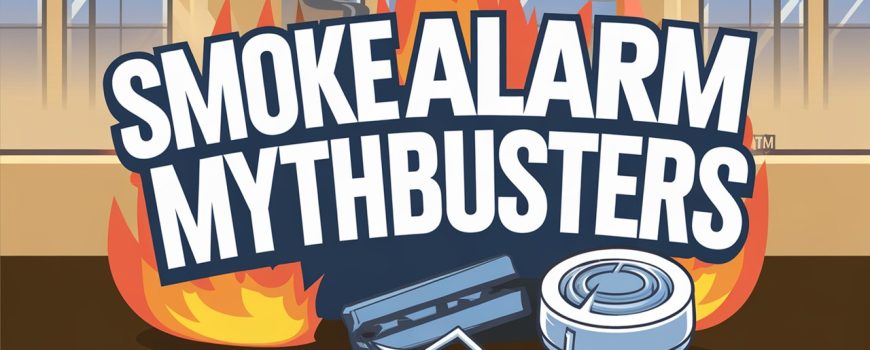Blog
Debunked! 10 Controversial Common Myths About Wireless Interconnected Smoke Detectors! (Part 2 Of 2)

Wireless interconnected smoke detectors are essential safety devices, but misinformation often keeps people from making the best choices. In this second part of our knowledge series we’ll bust another five myths about photoelectric smoke alarms so you can protect your home and loved ones more effectively.

MYTH 1: Wireless Interconnected Smoke Detectors
Are Not Necessary
REALITY: Some people believe that wireless interconnected smoke detectors are an unnecessary luxury. However, interconnected photoelectric smoke alarms significantly improve safety. When one alarm detects smoke, it triggers all the wireless interconnected smoke detectors in the house, ensuring that everyone is alerted, regardless of where the fire starts. Interconnected photoelectric smoke alarms are recommended by every Australian state fire department and will become mandatory by law for every Queensland home in 2027.
MYTH 2: Wireless Interconnected Smoke Detectors
Don’t Need Maintenance Or Cleaning
REALITY: Maintenance is crucial for all smoke alarms to function properly and wireless interconnected smoke detectors are no exception. wireless interconnected smoke detectors should be tested monthly. Additionally, wireless interconnected smoke detectors should be cleaned periodically to remove dust and debris that could impair their sensitivity. Neglecting these tasks can lead to false alarms or, worse, a failure to alert you in the event of a fire.
MYTH 3: All Wireless Interconnected Smoke Detectors
Are The Same
REALITY: There are two primary types of smoke alarms: ionization and photoelectric. Photoelectric smoke alarms are better at detecting smouldering fires, which are more common in home environments. They are less prone to false alarms from cooking or steam, making them more reliable in daily use. Additionally, photoelectric smoke detectors provide quicker warnings for slow-burning fires, offering more time to escape safely. It is for this reason that interconnected photoelectric smoke alarms such as ZEN are the preferred type by all fire authorities in Australia.

MYTH 4: Wireless Interconnected Smoke Detectors
Can Be Installed Anywhere
REALITY: Proper placement is key for effective smoke detection. ZEN wireless interconnected smoke detectors should be installed on every level of your home, inside bedrooms, and the hallway outside sleeping areas. Avoid placing wireless interconnected smoke detectors near kitchens or bathrooms where steam and cooking fumes could cause false alarms. Avoid placing wireless interconnected smoke detectors in areas prone to excessive dust or in semi-enclosed areas.
MYTH 5: I’ll Hear The Alarm And Have Plenty Of Time To Act
REALITY: Many people believe that the smell of smoke will wake them up, or that heat from a fire will give enough warning to respond calmly. However, fires can spread rapidly, often filling a home with thick, toxic smoke in just minutes, making escape difficult. Did you know that whilst asleep, your sense of smell ceases to function? This means you won’t smell the smoke, leaving you vulnerable to the dangers of fire. A wireless interconnected smoke detector system can alert you in time by sounding all alarms in the house when one is triggered, ensuring everyone has the precious seconds needed to wake up, react, and escape safely.
MYTH 6: Wireless Interconnected Smoke Detectors
Are Too Expensive
REALITY: Some homeowners believe that installing a wireless interconnected smoke detector system is too costly. However, the price of these life-saving devices is small compared to the potential loss caused by a house fire. Additionally, ZEN wireless interconnected smoke alarms offer easy DIY installation, eliminating the need for an electrician and saving on installation costs. Investing in high-quality interconnected photoelectric smoke alarms provides priceless peace of mind and ensures your family’s safety.
MYTH 7: Wireless Interconnected Smoke Detectors
Will Always False Alarm
REALITY: While some people worry that wireless interconnected smoke detectors will frequently trigger false alarms, modern photoelectric smoke alarms are specifically designed to reduce nuisance alarms. Unlike older ionization models, which can be sensitive to cooking fumes and steam, ZEN photoelectric smoke detectors are far more reliable, making them ideal for home use. Proper placement and occasional cleaning further help minimize false alarms while ensuring maximum protection.

MYTH 8: One Smoke Detector Is Enough for My Whole House
REALITY: A single smoke alarm cannot provide adequate protection, especially in multi-room or multi-level homes. Fire can spread quickly, and if a fire starts in a distant part of the house, a single detector may not alert everyone in time. Wireless interconnected smoke detectors ensure that when one alarm is triggered, all alarms sound, giving every occupant in the home the best possible chance to wake up and escape safely.
MYTH 9: Smoke Detectors Don’t Need to Be Replaced
If They Still Work
REALITY: Even if a smoke alarm appears to function, it should still be replaced every 10 years. Over time, smoke detectors can lose sensitivity, reducing their ability to detect fires effectively. ZEN wireless interconnected smoke detectors come with a built-in 10-year non-removable battery, meaning no battery replacements are ever needed. However, after a decade, the entire unit should be replaced to maintain optimal performance and compliance with safety regulations.
MYTH 10: I Have a Fire Extinguisher,
So I Don’t Need Smoke Detectors
REALITY: Fire extinguishers are useful for controlling small fires, but they don’t provide an early warning when a fire starts. If a fire breaks out while you’re asleep, a fire extinguisher won’t help if you aren’t aware of the danger. Wireless interconnected smoke detectors provide crucial early warning, giving you and your family time to escape before a fire becomes uncontrollable. A fire extinguisher is a great addition to your fire safety plan, but it should never replace properly installed and maintained smoke alarms.

We hope you have enjoyed this second and final part of our knowledge series article. By debunking common wireless interconnected smoke detector myths and recognizing the strengths of different types of alarms, you can make informed decisions that enhance your household’s fire readiness and overall safety. Understanding how these alarms work, their benefits, and proper placement can significantly improve your home’s protection. Stay tuned for more expert insights, practical fire safety tips, and essential information to help you safeguard your family, reduce risks, and stay prepared for any fire emergency.

Want to know more? Watch our ZEN Smoke Alarm YouTube channel or call us on 0478 596 402 today
We love talking smoke alarms!
ZEN Photoelectric Smoke Alarms
New Farm, QLD, 4005
